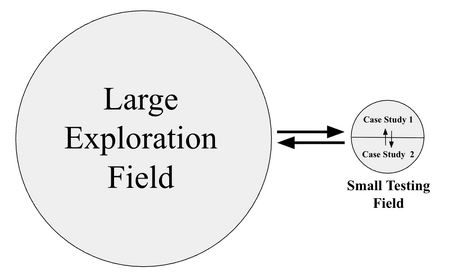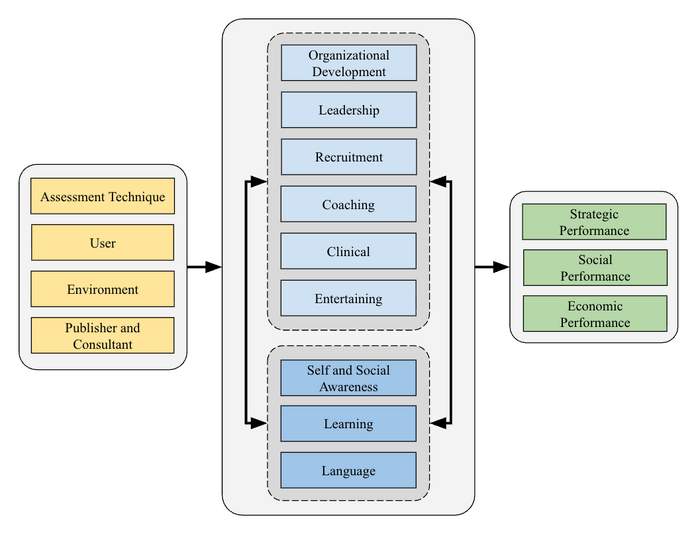GRI General Framework: Difference between revisions
| Line 30: | Line 30: | ||
The social performance includes a “quiet diversity” index that didn’t exist before. “Environment" includes a company's general politics, which used to be a moderating variable in the first model. It seemed more appropriate to consider it an antecedent variable. | The social performance includes a “quiet diversity” index that didn’t exist before. “Environment" includes a company's general politics, which used to be a moderating variable in the first model. It seemed more appropriate to consider it an antecedent variable. | ||
Although the first model discussed the parallel techniques, it didn’t include them. The new model allows comparisons of new advanced techniques | Although the first model discussed the parallel techniques, it didn’t include them. The new model allows comparisons of various techniques, including new advanced techniques based on statistics, and more primitive ones. | ||
[[File:GRI Model_detailed.png|center|700px]] | [[File:GRI Model_detailed.png|center|700px]] | ||
Revision as of 05:50, 19 September 2025
Introduction
This article presents the model used at GRI for analyzing the nature, use, and impact of assessment techniques on an organization's performance. Over the years, we have considered a variety of assessment techniques, including behavior assessments and private techniques, which we use ourselves privately.
The model was built in two phases over a 20-year period. During our research, we devised the GRI assessment and the adaptive profiles to remove limiting factors uncovered during the first phase. This has allowed us to evidence the assessment's usage by users in executive positions and operations rather than traditional expert users in HR and consulting only. This could not have been possible otherwise.
The model includes an analysis of assessment techniques’ use, users, publishers, and organizations using them. The dependent variable of the model, the organization’s performance, which is contingent upon individual performance, has guided our work. After a brief history of the model, this article reviews a few of its aspects. Other articles discuss the various components of the model.
First Model
The first model was built in the years 2002 to 2006 by Frederic Lucas-Conwell for his PhD thesis. The thesis demonstrated the positive effects of using personality assessments by managers on individual and group performance. The assessment techniques of the early 2000s were in constant progress. Software packages were providing increasing capabilities to analyze information and compute statistics. The building of the model followed social research academic standards, notably those of Miles and Huberman[1], Wacheux[2], and Eisenhardt[3].
A large exploration field consisted of 1,116 people from 501 companies whom Frederic met from 1995 to 2002. The organizations were from varied industries, different countries, and of different sizes. It allowed the collection of information on the uses of assessment techniques, their users, and their effects. The model was subsequently tested on two organizations, which are referred to as the case studies of the small testing field. The research process followed the diagram below. The arrows represent the interactions between the different fields.
The observations from the large field were from primary sources: direct observations of companies and their people, and secondary sources: testimony from publishing companies, consultants, journalists, and documents. The interaction between the large and small fields happened once the model was built. Observations from the small field and between the two case studies stimulated new observations on the large field, and vice versa, by going back and forth between the large and small fields, but only after the testing phase started. The model was successfully tested on case studies of the two small testing fields. The concepts, assessment techniques, and theories supporting the models in psychology, sociology, social-interactionism, organizational behavior, leadership, and semiotics (the analysis and philosophy of signs) had been documented in the dissertation report.
The 2025 Model
The first model provided the groundwork for a second phase from 2006 to 2025. After the first model was built, the GRI (Growth Resources Institute) was started in 2012, providing a platform for a new quality assessment inspired by the work on the first model. Personality assessments had solidly confirmed the universality and nature of the factors about to be used. The Internet was available for collecting, using, and analyzing data to unprecedented levels.
Although the observations were saturated after the first model, the advent of coaching and the use of typology assessment provided new grounds for the observations. The large exploration fields became more US-centric after 2005. The secondary sources included GRI consultants and their clients worldwide.
The new model would include assessment techniques other than personality. The GRI survey was built by removing limitations identified during the first phase. The inclusion of new techniques allowed broader analysis and comparison of assessment techniques. As identified in the first phase, assessment techniques both compete and complement each other.
With an increasing number of techniques that can be built in no time with AI, it has become urgent to understand how those assessment techniques differ, how the differences reflect in their use, and what different impacts users could really expect from them. The new model provided a solid framework for answering those questions.
Model Representation
The most recent research model is represented below. Different from the first model, the number of usage categories is now nine rather than six. “Clinical” was added, reflecting the increasing use of personality type assessments by clinicians. “Coaching” became a new category by itself. With primitive techniques and techniques used during large events, the model needed a category to regroup their use, which has been named “Entertainment.” The uses of the first and new models have been analyzed and detailed in a separate document.
The social performance includes a “quiet diversity” index that didn’t exist before. “Environment" includes a company's general politics, which used to be a moderating variable in the first model. It seemed more appropriate to consider it an antecedent variable.
Although the first model discussed the parallel techniques, it didn’t include them. The new model allows comparisons of various techniques, including new advanced techniques based on statistics, and more primitive ones.


